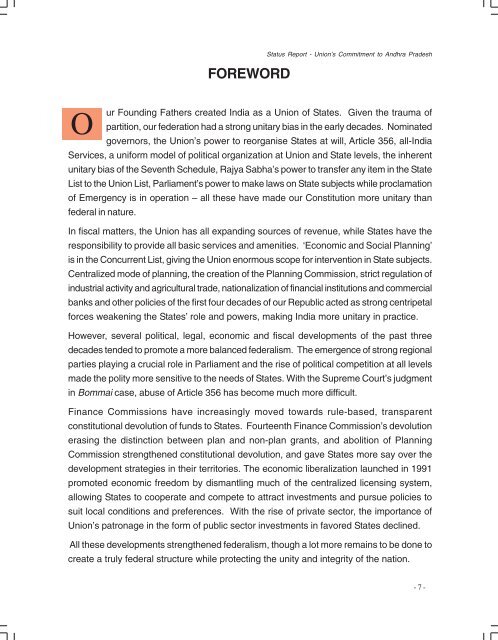State Reorganisation - Union's Commitment - Status Report
Create successful ePaper yourself
Turn your PDF publications into a flip-book with our unique Google optimized e-Paper software.
FOREWORD<br />
<strong>Status</strong> <strong>Report</strong> - Union’s <strong>Commitment</strong> to Andhra Pradesh<br />
O<br />
ur Founding Fathers created India as a Union of <strong>State</strong>s. Given the trauma of<br />
partition, our federation had a strong unitary bias in the early decades. Nominated<br />
governors, the Union’s power to reorganise <strong>State</strong>s at will, Article 356, all-India<br />
Services, a uniform model of political organization at Union and <strong>State</strong> levels, the inherent<br />
unitary bias of the Seventh Schedule, Rajya Sabha’s power to transfer any item in the <strong>State</strong><br />
List to the Union List, Parliament’s power to make laws on <strong>State</strong> subjects while proclamation<br />
of Emergency is in operation – all these have made our Constitution more unitary than<br />
federal in nature.<br />
In fiscal matters, the Union has all expanding sources of revenue, while <strong>State</strong>s have the<br />
responsibility to provide all basic services and amenities. ‘Economic and Social Planning’<br />
is in the Concurrent List, giving the Union enormous scope for intervention in <strong>State</strong> subjects.<br />
Centralized mode of planning, the creation of the Planning Commission, strict regulation of<br />
industrial activity and agricultural trade, nationalization of financial institutions and commercial<br />
banks and other policies of the first four decades of our Republic acted as strong centripetal<br />
forces weakening the <strong>State</strong>s’ role and powers, making India more unitary in practice.<br />
However, several political, legal, economic and fiscal developments of the past three<br />
decades tended to promote a more balanced federalism. The emergence of strong regional<br />
parties playing a crucial role in Parliament and the rise of political competition at all levels<br />
made the polity more sensitive to the needs of <strong>State</strong>s. With the Supreme Court’s judgment<br />
in Bommai case, abuse of Article 356 has become much more difficult.<br />
Finance Commissions have increasingly moved towards rule-based, transparent<br />
constitutional devolution of funds to <strong>State</strong>s. Fourteenth Finance Commission’s devolution<br />
erasing the distinction between plan and non-plan grants, and abolition of Planning<br />
Commission strengthened constitutional devolution, and gave <strong>State</strong>s more say over the<br />
development strategies in their territories. The economic liberalization launched in 1991<br />
promoted economic freedom by dismantling much of the centralized licensing system,<br />
allowing <strong>State</strong>s to cooperate and compete to attract investments and pursue policies to<br />
suit local conditions and preferences. With the rise of private sector, the importance of<br />
Union’s patronage in the form of public sector investments in favored <strong>State</strong>s declined.<br />
All these developments strengthened federalism, though a lot more remains to be done to<br />
create a truly federal structure while protecting the unity and integrity of the nation.<br />
- 7 -


